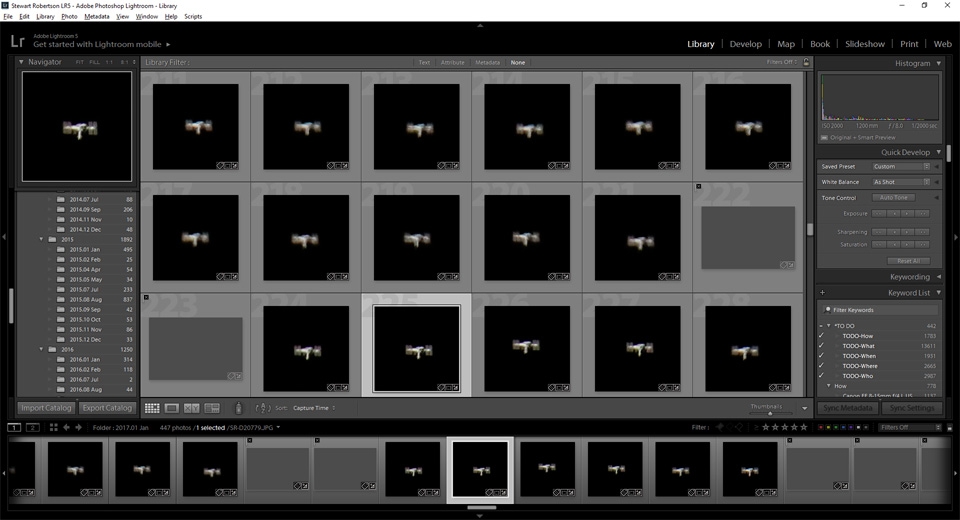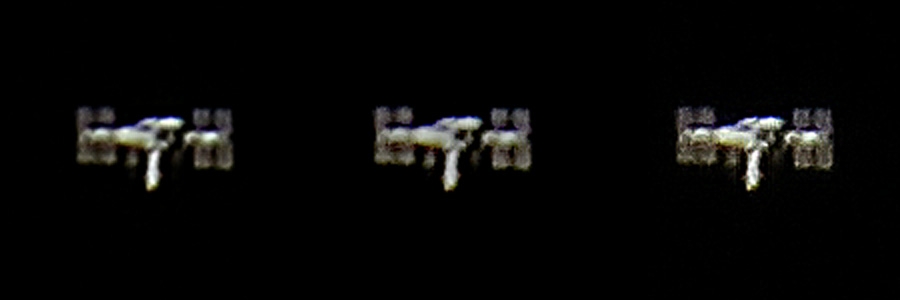Wait, I didn't realise you could do this. How?
Actually it's not trivial.
The ISS orbit is inclined at 51.6° to the equator, so if you draw the orbit on a regular rectangular map of the world it looks like a sine wave with the peaks at 51.6°N and 51.6°S. Where I live in Maidenhead is at 51.5°N latitude, so at certain points in its orbit the ISS passes directly overhead; it rises in the west, passes overhead, and sets in the east. There are other lower-altitude passes, of course, when the peak of the sine wave is at a different longitude.
You can get predictions for ISS passes from sites like Heavens Above. In the UK you typically get a couple of weeks when you get one or two visible passes pre-dawn every morning, then a few weeks when it isn't visible, then a couple of weeks when you get one or two visible passes immediately post-sunset every evening.
The ISS is about 100m across and it's 400km away even when it's overhead. However photographing it when it's directly overhead is very awkward, so my photos are taken when it has an altitude of perhaps 45-60° above the horizon and that means it's probably 500-600km away. So it's obvious that you need the biggest lens you can lay your hands on, and even then its just a tiny speck in the viewfinder. For example, today I used a 600mm lens with a 2x extender, on a 24-megapixel crop-sensor Canon 80D, and even so the image of the ISS posted here was only 75 pixels across. In round numbers that's very roughly 1 pixel per metre measured on the ISS. A big lens means a good tripod and a smooth gimbal head, of course.
Focusing is critical. There's no chance of using autofocus so you have to focus manually, and the ISS is so small and moving so fast (we'll talk about that in a minute) that you can't realistically focus on it. So you need to pre-focus manually. This morning I had Jupiter in the southern sky, which made an excellent bright target, so I focused on that using 10x live view before the ISS made its appearance. OK, Jupiter is 800,000,000km away and the IS is only 400km, but that's within the depth of field.
Exposure is interesting. It's easy to overlook the fact that the ISS is in bright sunlight, so the Sunny-16 rule applies, sort-of. If you use, say, ISO 400, the rule says 1/400th at f/16. In practice I find the ISS is a couple of stops darker than that (maybe because of the angle of the sun?) so it needs a couple more stops of exposure: with ISO 400 it would be 1/400th at f/8. And that's convenient because f/8 is the widest aperture I can achieve with that lens and extender.
But in practice I don't use ISO 400 and 1/400th at f/8; I use something like ISO 2000 and 1/2000th at f/8. The reason is that the ISS is moving very fast, and it's very difficult to track it accurately, so I want to minimise the risk of blurring it through having too slow a shutter speed. The orbital velocity is around 8,000 m/s, and we saw earlier that with my setup I have roughly 1 pixel per metre of ISS. so in my exposure time of 1/2000th the ISS travels about 4m, which is about 4 pixels, and I'm panning to try to make it sharp at the pixel level. And in fact it's absolutely necessary to pan, because with an image that's 4000 pixels from top to bottom, the ISS will traverse the view in roughly half a second if I don't pan!
So that's where it starts to get fun. You've got a very big lens with a very small field of view (roughly the size of the moon) and you're trying to locate a tiny object that's moving very fast. It takes a bit of practice to even find the wretched thing, and then when you do you have to start panning as smoothly as possible, while crouching down more and more as the target rises higher into the sky. I shoot as many frames as I can (6 fps on the 80D, I think) because I can guarantee some of them are going to be ruined by inaccurate panning and/or atmospheric instability. If your hand so much as twitches or if the panning isn't smooth, you'll lose the target, and you have to reacquire it.
Great fun! But definitely worth a go if you have access to suitable gear.






